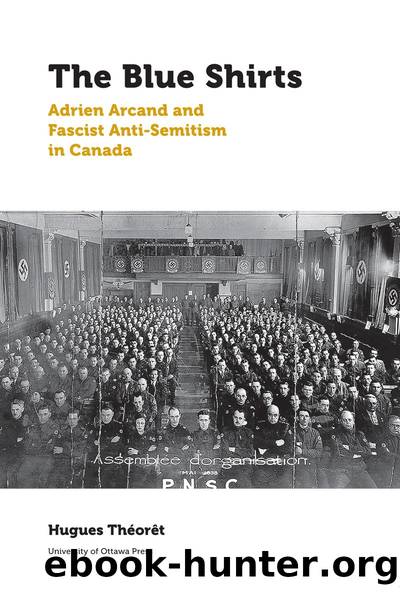The Blue Shirts by unknow

Author:unknow
Language: eng
Format: epub
Tags: Nonfiction, History
ISBN: 9780776624693
Publisher: University of Ottawa Press
Published: 2017-05-16T04:00:00+00:00
Canadian Fascists Under Scrutiny by the Authorities
How can we explain how Arcand and the NUPC were able to freely disseminate their fascist, anti-war propaganda when Canada was on the verge of entering the Second World War? As Martin Robin points out, Canada was not very concerned about Canadian fascists before 1938: âAlthough the noisy minorities had long sounded the alarm, there was no real public contemplation of a domestic fascist threat until the spring and summer of 1938, a discovery encouraged by Arcandâs gluttonous publicity urge and, more important, by Hitlerâs menacing conquests abroad.â44
Although the first pressure groupsâthe Canadian Jewish Congress, primarilyâhad, beginning in 1937, alerted the authorities about Arcandâs activities, it was only in 1938 that the general population was beginning to become concerned about the presence of fascists in Canada. In fact, the media were the first to brandish the fascist threat in the country. After Nazi Germany annexed Austria in the spring of 1938, the international press expressed frequent concern about Hitlerâs imperialism, and then Canadian and American media suddenly became interested in Arcand and his movement. The Montreal Gazette was the first daily to warn its readers. In January 1938, it published a series of articles on Arcandâs National Social Christian Party and showed fascists in uniforms doing military-style exercises. The Globe and Mail was also paying special attention to Arcandâs blueshirts by publishing articles about fascism in Canada. In April 1938, Macleanâs magazine published two very detailed articles on the existence of a fascist movement in Canada. The Canadian fascists also caught the attention of major American dailies, including the New York Times and the Boston Globe, which devoted articles to them. In February 1938, the progressive US weekly The Nation published a long interview with Arcand. Life magazine even ran several pages on Arcand in its April 18 issue that year. But all this media attention was a double-edged sword for Arcand and his troops. By placing himself in the spotlight, Arcand was trying to increase his popularity, but it also aroused his opponents. Military personnel and civilians were mobilizing to express their opposition to Canadian fascists. The Canadian Armed Forces, the Royal Canadian Legion, the Daughters of England, and the union federations in the country used petitions and letters to Prime Minister Mackenzie King to denounce the propaganda of the Canadian fascists.45 In the spring of 1938, after the Montreal clergy, the leader of the Liberal Party of Quebec and future premier, Adélard Godbout, presented the Canadian fascists as a threat to democracy: âFascism is more dangerous than communism in our country, because it has numerous followers and advanced means of action. We will have to restore order if we want to safeguard democracy and responsible government.â46
Godboutâs evaluation of the danger of fascists and their strength in Quebec and Canada then was no doubt exaggerated. Contrary to what Godbout claimed, Arcandâs party was little more than ânumerous,â and it did not possess âadvanced means of action.â His party had recurring financial problems (his
Download
This site does not store any files on its server. We only index and link to content provided by other sites. Please contact the content providers to delete copyright contents if any and email us, we'll remove relevant links or contents immediately.
| Action & Adventure | Aliens |
| Dystopian | Space Opera |
| Steampunk | Time Travel |
Among the Betrayed by Margaret Peterson Haddix(11510)
Six of Crows by Leigh Bardugo(9982)
Harry Potter and the Cursed Child - Parts One and Two Playscript by J.K. Rowling & John Tiffany & Jack Thorne(8075)
Quests for Glory by Soman Chainani(7050)
Shadow and Bone by Leigh Bardugo(6628)
05 Trials of Death by Darren Shan(6322)
Ranger's Apprentice 1 - The Ruins of Gorlan by John Flanagan(5799)
The Silver Mask by Holly Black & Cassandra Clare(5381)
Percy Jackson 1 - The Lightning Thief by Riordan Rick(4814)
Siege and Storm by Leigh Bardugo(4801)
His Dark Materials 1 - The Golden Compass by Philip Pullman(4483)
Super Sales on Super Heroes by Arand William D(4394)
Harry Potter 2 - Harry Potter and the Chamber of Secrets by J. K. Rowling & Mary Grandpré(4164)
The School for Good and Evil #2: A World without Princes by Chainani Soman(4067)
The miraculous journey of Edward Tulane by Kate DiCamillo(4046)
Erebos by Ursula Poznanski(3650)
Crooked Kingdom: A Sequel to Six of Crows by Leigh Bardugo(3632)
The Vampire War by Michelle Madow(3632)
07 Hunters of the Dusk by Darren Shan(3630)
